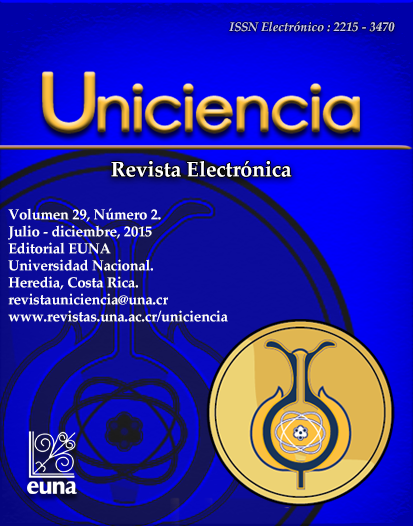ICT-projects-modeling based experience for teaching of systems of differential equations
DOI:
https://doi.org/10.15359/ru.29-2.4Keywords:
ICT, projects, modeling, Differential-equationsAbstract
One of the challenges in education is the continuous improvement in order to search for new strategies in the management of teaching and learning and the quality of the process. The incorporation of ICTs (Information and Communication), project teaching and mathematical modeling propose a strategy for teaching of systems of differential equations at the university level. The implementation showed favorable results on the students, who had to schematically describe the problem, raise the mathematical model, perform and analyze simulations and predictions, in all cases with problems related to the student's academic area.
References
Alfaro, A., Alpízar, M. & Chaves, E. (2012). Recursos metodológicos utilizados por docentes de I y II ciclos de la educación general básica en la dirección regional de Heredia, al impartir los temas de probabilidad y estadística. Revista Uniciencia, 26 (1 y 2), 135-151.
Angel, J. & Bautista, G. (2001). Didáctica de las matemáticas en enseñanza superior: la utilización de software especializado. Recuperado de: http://www.uoc.edu/web/esp/art/uoc/0107030/mates.html#bibliografia.
Belando, M. (2014). Formación permanente del profesorado. Algunos recursos TIC para la docencia universitaria. Revista Iberoamericana de Educación, 65 (1), 1-11.
Castillo, S. (2008). Propuesta pedagógica basada en el constructivismo para el uso óptimo de las tic en la enseñanza y el aprendizaje de la matemática. Revista Latinoamericana de Investigación en Matemática Educativa, 11(2), 171-194.
Cerda, C. (2002). Elementos a considerar para integrar tecnologías del aprendizaje de manera eficiente en el proceso enseñanza-aprendizaje. Revista de Estudios Pedagógicos, 28, 179-191.
Chavarría, G. (2014). Dificultades en el aprendizaje de problemas que se modelan con ecuaciones lineales: El caso de estudiantes de octavo nivel de un colegio de Heredia. Revista Uniciencia, 28(2), 15-44.
De Faria, E. (2001). Simulaciones con calculadora graficadora TI-89/92+. Recuperado de: http://www.cidse.itcr.ac.cr/ciemac/memorias/2CIEMAC/Ponencias/Simulaciones_con_la_calculadora(Edison).pdf
Fernández, M. (2000). Perfeccionamiento de la enseñanza-aprendizaje del tema límite de funciones con el uso de un asistente matemático. Revista Latinoamericana de Investigación en Matemática Educativa 3(2), 171-187.
Gatica, S. y Ares, O. (2012). La importancia de la visualización en el aprendizaje de conceptos matemáticos. Revista de Educación Mediática y TIC, 1(2), 88-107.
Herrera, M. (2004). Las nuevas tecnologías en el aprendizaje constructivo. Revista Iberoamericana de Educación, 34(4), 1-20.
Macías, D. (2007). Las nuevas tecnologías y el aprendizaje de las matemáticas. Revista Iberoamericana de Educación, 42, 4–10.
Morales, Y. (2009). Enfoques y dificultades en aprendizaje de las ecuaciones diferenciales. Recuperado de: http://www.soarem.org.ar/Documentos/45%20Morales.pdf
Morales, Y. y Salas, O. (2010). Incorporación de la tecnología para la enseñanza y aprendizaje de las Ecuaciones Diferenciales Ordinarias (EDO). Cuadernos de Investigación y Formación en Educación Matemática, 6 (1), 155-172.
Moursund, D. (1999). Aprendizaje por Proyectos con las TIC (capítulos I y II). Recuperado de: http://www.eduteka.org/modulos.php?catx=7&idSubX=184&ida=563&art=1.
Paredes, Z., Iglesias, M., & Ortiz, J. (2009). Los docentes y su formación inicial hacia el aula de matemática: Una propuesta con modelización y nuevas tecnologías. Revista Iberoamericana sobre Calidad, Eficacia y Cambio en Educación, 7(1), 86-102.
Perdomo, J. (2011). Módulo de enseñanza para la introducción de las ecuaciones diferenciales ordinarias en un ambiente de resolución de problemas con tecnología. Revista de Didáctica de las Matemáticas, 78, 113-134.
Ré, M., Arena, L. y Giubergia, M. (2012). Incorporación de TICs a la enseñanza de la Física: Laboratorios virtuales basados en simulación. Revista Iberoamericana de Educación en Tecnología y Tecnología en Educación, 8, 16-22.
Villalobos, J., Brenes, S. & Mora, S. (2012). Herramienta asistida por computadora para la enseñanza del álgebra relacional en bases de datos. Revista Uniciencia, 26, 179-195.
Downloads
Published
Issue
Section
License
Authors who publish with this journal agree to the following terms:
1. Authors guarantee the journal the right to be the first publication of the work as licensed under a Creative Commons Attribution License that allows others to share the work with an acknowledgment of the work's authorship and initial publication in this journal.
2. Authors can set separate additional agreements for non-exclusive distribution of the version of the work published in the journal (eg, place it in an institutional repository or publish it in a book), with an acknowledgment of its initial publication in this journal.
3. The authors have declared to hold all permissions to use the resources they provided in the paper (images, tables, among others) and assume full responsibility for damages to third parties.
4. The opinions expressed in the paper are the exclusive responsibility of the authors and do not necessarily represent the opinion of the editors or the Universidad Nacional.
Uniciencia Journal and all its productions are under Creative Commons Atribución-NoComercial-SinDerivadas 4.0 Unported.
There is neither fee for access nor Article Processing Charge (APC)






